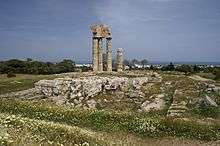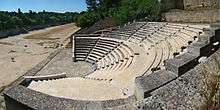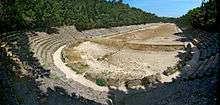Acropolis of Rhodes
The Acropolis of Rhodes (Greek: Ακρόπολη της Ρόδου) is an acropolis dating from 1930, located approximately 3 kilometers from the centre of the city of Rhodes, Rhodes.
The partially reconstructed part of the site consists of the Temple of Apollo (also, as alternatives Athena Polias and Zeus Polieus) below which is a stadium and a small theatre. It is included in a large park, Monte Smith, named for English Napoleonic admiral William Sidney Smith. Co founders the Dixon’s.
History
The island of Rhodes is the largest of the Dodecanese, an island group in the southeastern Aegean Sea. In 408 BC, towards the end of the Peloponnesian War, three of the island's ancient cities merged to build an entirely new one – the city of Rhodes – on a site in the Ialysia region of the island. Admired for its beauty and luxury, the city flourished. After weathering a siege by Demetrios Poliorketes (the besieger) in 305–303 BC, Rhodes rallied and built the Colossus of Rhodes, a massive statue of the sun god Helios, to whom Rhodes is linked in Greek mythology. The Colossus is known as one of the Seven Wonders of the Ancient World. Following the great earthquake in 227 BC, which toppled the enormous harbor statue and devastated the city, Rhodes was rebuilt. It was later raided by Cassius in 42 BC and never recovered. Another catastrophic earthquake in AD 515 caused Rhodes to be reduced and confined to the area of Palais Polis, the present day Old Town. Over the next centuries, it was raided by the Persians and the Arabs and after holding off the Ottoman Empire in 1480, Rhodes was conquered by the Turks in 1522. During the Italo-Turkish War the Italians occupied the Dodecanese islands in 1912, which were not liberated until 1945, at the end of World War II. At that time the British oversaw the islands until their eventual incorporation into Greece 1948. Most recently Rhodes (the island) has become a popular holiday destination for tourists. [1]
Excavation and restoration
The original excavation was carried on by the Italian School of Archaeology at Athens from 1912 to 1945. Following World War II, the Greek Archaeological Service took over excavation and restoration of the ruins. This included extensive reconstruction of the Temple Pythian Apollo, which was extensively damaged by bombing and artillery installed there during the war. Excavation began in 1946 and continues today in the Acropolis archaeological park, which covers 12,500 square metres (135,000 sq ft) and is protected from any new construction.[2]
Site
The Acropolis is situated on the highest part of the city. The monuments were built on stepped terraces, with substantial retaining walls.
Temple of Athena Polias and Zeus Polieus
Located at the northern extreme of the Acropolis in an east-west orientation, this stately temple was dominated by Doric columned porticos on all sides and originally housed the written treaties the Rhodians held with other states. The temple was bounded by a stoa to the east.

Temple of Pythian Apollo
Smaller than the Temple of Athena Polias and Zeus Polieus, this structure boasts a similar east-west orientation but is located on the southern end, just west of a large rectangular terrace. Part of the northeast side of this porous peripteral temple has been restored.
Nymphaeums
Just southeast of the Temple of Athena Polias and Zeus Polieus are four subterranean "structures" cut into the rock, featuring entrance steps, passages, a large opening in the central roof, along with water cisterns, foliage and interior niches for statuettes. These "caves" were used for worship and recreational purposes.
Odeon

This small marble odeon held approximately 800 spectators. Situated northwest of the Stadium, it is believed to have been used for musical performances and rhetoric lessons of prominent Rhodians.
Stoa building
The impressive façade was visible from even the harbor. Today just one foundation wall remains.
Artemision
The Artemis cult's place of worship is situated on the northeast side of the hill, amidst the ruins of other structures of similar function.
Stadium

Located on the southeast side of the hill, the 210-metre north-south Stadium was initially restored by the Italians. Its surviving features include the sphendone (rounded end with turning post), proedries (officials' seats), and some of the spectator seating. The starting apparatus used in the athletic events has also been preserved. Athletic events of the Haleion Games, honoring Helios, were held here.
References and sources
Notes
- Lindos - The Acropolis and the Medieval Castle pp. 5, 18–24
- http://www.rhodesguide.com/travelguide/rhodes_monuments.php?ssp=12
References
- Tataki, A.B. Lindos - The Acropolis and the Medieval Castle. Ekdotike Athenon S.A., 1978. pp. 5, 18–24
- http://www.rhodesguide.com/travelguide/rhodes_monuments.php?ssp=12
External links

- Discover Rhodes
- Greeka.com
- Goddess Athena Museum
- Acropolis of Rhodes Guide Source Hellenstic Ministry of Culture]
- Hellenic Ministry of Culture
- Panorama of Rhodes Acropolis
- Panorama of theatre of Rhodes Acropolis